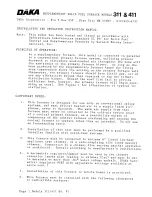
15
START-UP AND ADJUSTMENTS
Pre-Start Check List
√
V
erify the polarity of the connections are correct, the
line voltage power leads are securely connected and
the furnace is properly grounded.
√
V
erify the thermostat wires (
R
,
W
,
Y
, and
G
) are
securely connected to the correct leads on the
terminal strip of the circuit board.
√
V
erify the gas line service pressure does not exceed
10.0 inches of W.C., and is not less than 4.5 inches
W.C. for natural gas. For LP gas the line service
pressure must not exceed 14 in. W.C., and must not
be less than 11.0 in. W.C.
√
V
erify the roll-out and manual reset switch is closed.
If necessary, press the red button to reset a switch.
If a switch reopens on startup, DO NOT reset the
switch without identifying and correcting the fault
condition.
DO NOT install a jumper wire across a
switch to defeat its function.
√
V
erify the blower door is in place, closing the door
switch in the line voltage circuit.
√
V
erify the gas line has been purged and all connections
are leak free.
Start-up Procedures
Do not perform these steps until all of the checks in the
previous steps have been completed:
1. Set the thermostat to the lowest setting.
2. Turn off all electrical power to the furnace.
3. Follow the Operating Instructions on the label attached
to the furnace.
4. Set the thermostat above room temperature and verify
the Operating Sequence (Page 17).
5. After 5 minutes of operation, set the thermostat
below room temperature and verify steps 9 - 10 of
the Operating Sequence.
Verifying and Adjusting Input Rate
The input rate must be verifi ed at installation to prevent
over-fi ring of the furnace.
The input rate must not exceed
the specifi cation listed on the furnace rating plate. At
altitudes above 2,000 feet, it must not exceed that on
the rating plate less 4% for each 1,000 feet.
To determine
the exact input rate, perform these steps:
Grounding
WARNING:
To minimize personal injury, the furnace cabinet
must have an uninterrupted or unbroken electrical
ground. The controls used in this furnace
require an earth ground to operate properly.
Acceptable methods include electrical wire or
conduit approved for ground service. Do not
use gas piping as an electrical ground!
1. Shut off all other gas fi red appliances.
2. Start the furnace and run it for at least 3 minutes.
3. Measure the time (in seconds) required for the gas
meter to complete one revolution.
4. Convert the time per revolution to cubic feet of gas
per hour using Table 6 (page 25).
5. Multiply the gas fl ow rate in cubic ft per hr by the
heating value of the gas in Btu per cubic ft to obtain
the input rate in Btuh. See example.
6. The manifold pressure must be set to the appropriate
value for each installation by a qualifi ed installer,
service agency or the gas supplier.
WARNING:
Do not attempt to drill the gas orifi ces. Use
only factory supplied orifices. Improperly
drilled orifi ces may cause fi re, explosion,
carbon monoxide poisoning, personal injury
or death.
a.) Obtain the manifold pressure setting required for
this installation by referring to Table 8 (page 26)
for Natural Gas or Table 9 for Propane gas
b.)
Remove the regulator capscrew (Figure 14) from
the INLET side of the regulator.
c.) Slowly turn the adjustment screw inside the
regulator to obtain the appropriate manifold
pressure.
NOTE:
Turning the screw clockwise
increases the pressure and turning the screw
counter-clockwise decreases the pressure. To
prevent backing the screw all the way out from
the valve, turn the screw slowly.
d.) Replace and tighten the regulator capscrew over
the adjustment screw.
Capscrew
Figure 14. Regulator Capscrew
Example
:
• Time for 1 revolution of a gas meter with a 1
cubic ft dial = 40 seconds.
• From Table 6 read 90 cubic ft gas per hr.
• Local heating value of the gas (obtained from
gas supplier) = 1,040 Btu per cubic ft.
• Input rate = 1,040 x 90 = 93,600 Btuh.
Содержание G7XA Series
Страница 2: ...2...










































